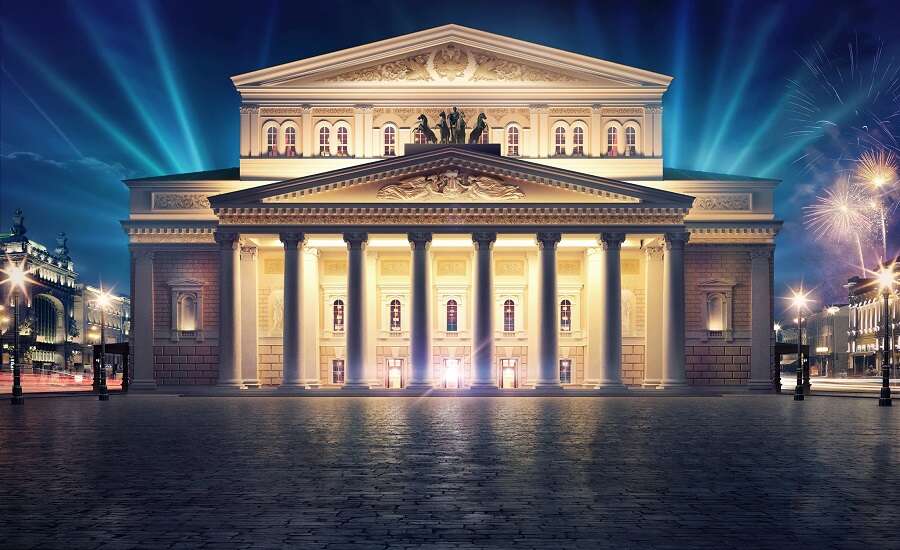
Photo from https://www.bolshoi.ru/
The Bolshoi Theatre is Russia’s national theatre, and has had an astounding influence on the history and development of Russian performing arts. Since its foundation nearly 250 years ago, the Bolshoi has become synonymous with world-class opera and ballet, and there is no better place to appreciate the magic of Russian dance, music, and theatre. While visiting Moscow don't miss it!
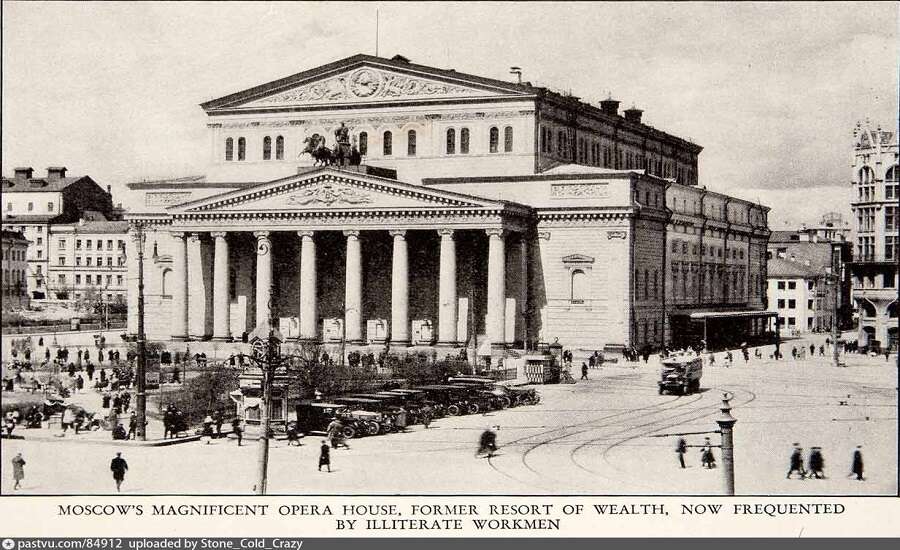
Photo from https://pastvu.com/
The Bolshoi Theatre was founded in 1776 as a private theatre for Moscow Prosecutor, Prince Peter Urusov, to hold performances, masquerade balls, and other events. Its artists were assembled from all over – not just established international stars, but also members of serf theatres, and children from the Moscow Orphanage who were trained in theatre and dance. Moscow State University and its affiliated schools played a key role in training members of the theatre company. The theatre’s co-founder was English entrepreneur and theatre manager, Michael Maddox, who enhanced the performances by devising ingenious mechanical sets.
After burning down in 1780, the theatre was reopened on Petrovka Street, gaining the name ‘Petrovsky Theatre’. The opening spectacle of the Petrovsky Theatre, a ballet performance and literary reading, took place on 30th December 1780. Under Maddox’s leadership from 1780 to 1794, the theatre troupe gave over 400 performances.
At the beginning of the 19th century, the Petrovsky Theatre began its transformation into something which would even exceed the scale and grandeur of St Petersburg’s Bolshoi Kamenny Theatre, which was at the time the principal theatre of the Imperial Ballet and Opera. The Petrovsky’s artists began training at the Imperial Moscow Theatre School. In 1820, construction of a brand new theatre began, designed by architect Osip Bove; the ‘Bolshoi Petrovsky’ finally opened on 6th January 1825. The Neoclassical building of the Bolshoi Petrovsky reflected the wonders which took place within. Its majestic façade looked out onto Teatralnaya Square, and atop its columned portico stood a statue of Apollo – the Greek and Roman god of music, dance, and poetry.
The repertoire of the Bolshoi Petrovsky by this point was focussed on opera and ballet, and was updated regularly to present the newest artistic works to the Bolshoi’s audience. The works of many famous Russian and European composers were premiered there from the mid-19th to the early 20th century, including those by Tchaikovsky, Rimsky-Korsakov, Mussorgsky, and Rachmaninov, as well as Verdi and Wagner. By the turn of the 20th century the Bolshoi Theatre’s performances had gained profound influence throughout the West.
Did you know? The Bolshoi Theatre burnt down four times! First in 1780, then in 1805, again during the Napoleonic invasion of Moscow in 1812, and then once more in 1853.
Chief architect of the imperial theatres, Albert Kavos, was responsible for reconstructing the theatre in the mid-1850s in an even grander form. The new theatre could accommodate over 2,000 spectators and had world-class acoustics and crystal chandeliers illuminating its six-tiered hall, which was designed in Renaissance and Byzantine style and decorated with gold and crimson. A mural ‘Apollo and the Muses’ adorned the ceiling.
Did you know? The Bolshoi Theatre is depicted on the 100 rouble banknote.
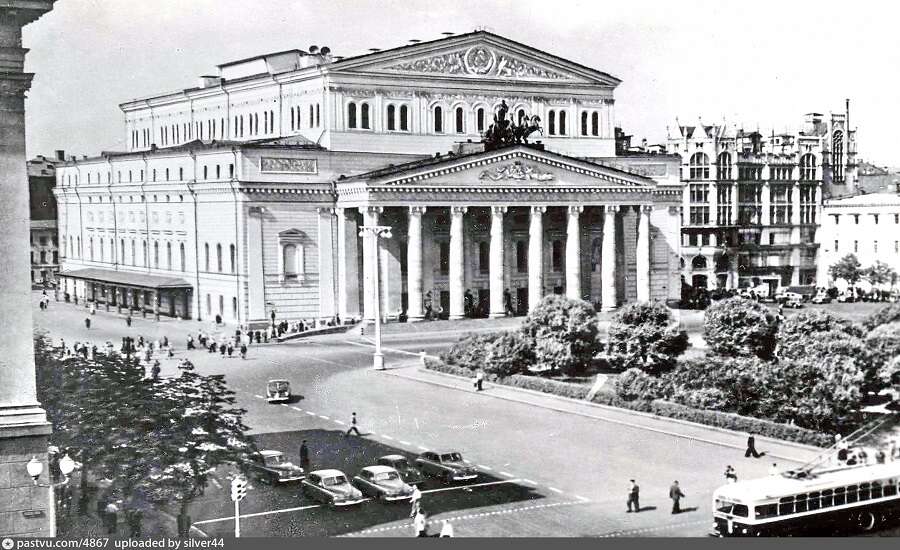
Photo from https://pastvu.com/
The final performance of the Imperial Bolshoi Theatre took place on 28th February 1918, after which time the theatre became state property. The future of the Bolshoi seemed uncertain, as the ‘high arts’ of ballet and opera did not fit in with Soviet ideology and were perceived as a ‘relic of the bourgeois past’. However, the Bolshoi Theatre’s proximity to the Kremlin made it an ideal venue for political events, and the All-Russian Congresses of Soviets, meetings of the All-Russian Central Executive Committee, and congresses of the Comintern were held there.
Did you know? The formation of the USSR was officially proclaimed from the stage of the Bolshoi Theatre!
The Bolshoi Theatre’s activities continued throughout the Soviet period, with classical Russian and foreign performances, ideologically sound adaptations, and new performances by Soviet composers and directors. Notable Soviet works premiered at the Bolshoi included Shostakovich’s opera Lady Macbeth of Mtensk, and Khachaturian’s ballet Spartak. The international prestige held by the Bolshoi Ballet company continued after the death of Stalin, when the company began touring outside of Russia.
The Bolshoi Theatre company was evacuated to Kuibyshev (now known as Samara) during the Second World War, where they continued to perform. Restoration work was undertaken during wartime after the theatre suffered a direct hit from enemy bombardment, and the theatre reopened in autumn 1943 with a performance of Glinka’s opera A Life for the Tsar, which had been premiered at the Bolshoi a century earlier.
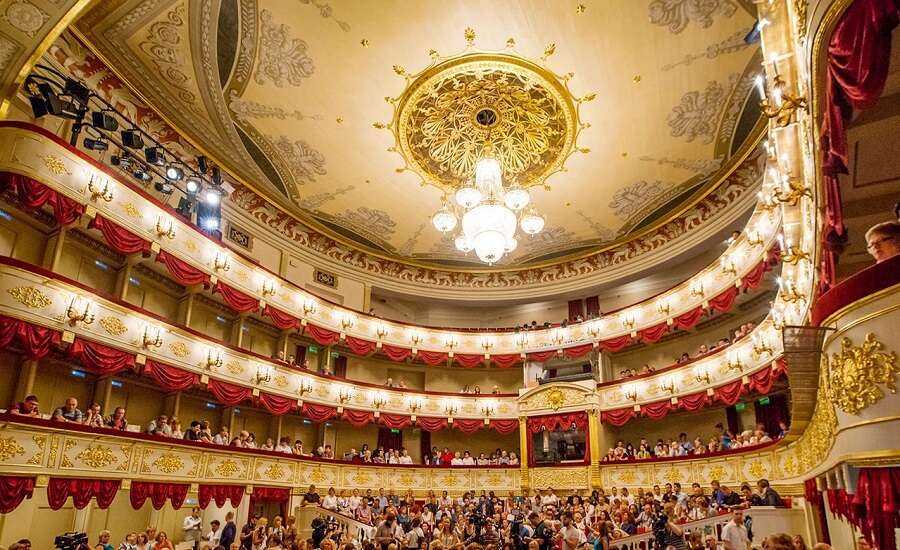
Photo from https://www.culture.ru/
In 2002, the New Stage was opened to continue the work of the Bolshoi Theatre whilst it underwent extensive reconstruction. The restoration work included a return to the imperial-era décor and the acoustics designed by Kavos. The Historic Stage of the Bolshoi Theatre finally reopened on 28th October 2011, with an exclusive gala concert attended by Vladimir Putin and Dmitry Medvedev.
Did you know? The artisans in charge of recreating the Bolshoi’s imperial interiors resorted to some… unusual traditional methods. To apply the gold leaf, they first painted the underlying surface with a mixture including clay, whale grease and rotten egg whites, then used a squirrel tail brush to apply vodka onto the surface, before laying sheets of gold leaf.
The Bolshoi Theatre company has grown from 40 artists in 1785, to more than 900 today. It comprises the Bolshoi Ballet and Opera companies, the Bolshoi Theatre Orchestra, and the Scenic Brass Orchestra. Its artists have received a huge number of state prizes, both in the Soviet period and today.
Today, the Bolshoi Theatre showcases classical Russian and foreign masterpieces whilst actively supporting the creative development of Russian ballet and opera, for example with new compositions commissioned especially for performance at the Bolshoi, and the Young Artists Opera Program. Its repertoire primarily encompasses masterpieces of Russian ballet and opera from the 19th and 20th centuries, and you can really get a feel for the splendour of the Imperial Bolshoi Theatre by attending one of these performances. The Bolshoi Theatre has just restarted ticket sales for its 245th season, which begins on 6th September.
Did you know? The Bolshoi Theatre did not totally cease its performances during the Covid-19 pandemic. A concert entitled ‘We Are Together’ was broadcast live from the empty Bolshoi Theatre, starring actors, singers, dancers and orchestral members from the Bolshoi and elsewhere, to show thanks to doctors and essential workers. The Bolshoi also began broadcasting its previous performances; one million people watched Swan Lake on the first day of the broadcast.
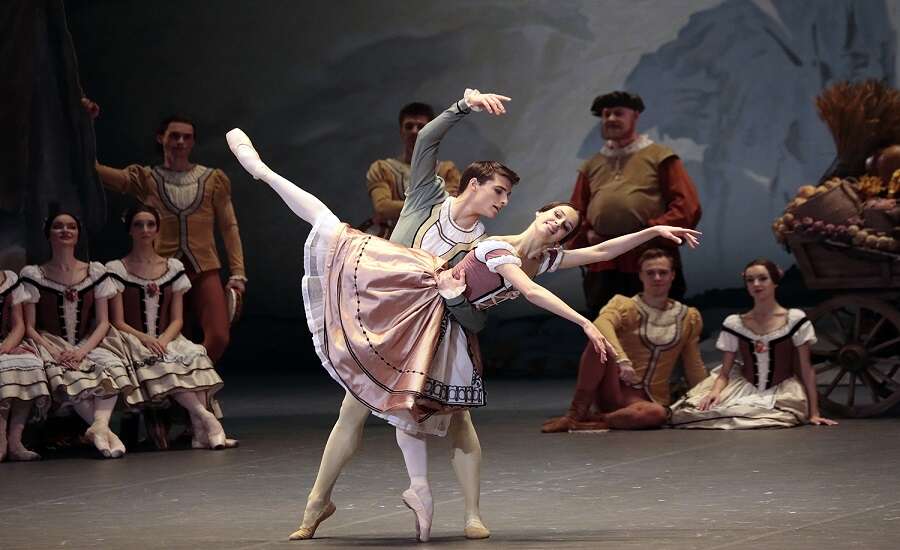
Photo from https://www.bolshoi.ru/
The Bolshoi Ballet company has existed as long as the theatre itself. Its reputation began to increase under Ballet Master Alexander Gorsky at the turn of the 20th century, who injected a unique identity and bold, natural choreography into more traditional ballets such as Swan Lake and The Nutcracker. Gorsky’s style is still seen at the Bolshoi today, and contrasts the more traditional and classical style of performances at St Petersburg’s Mariinsky Theatre.
Today, the Bolshoi Ballet company is the largest in the world, led by artistic director Makhar Vaziev. It primarily performs works from the 19th and 20th centuries, such as Tchaikovsky’s Swan Lake, The Nutcracker, and Sleeping Beauty (the former was premiered at the Bolshoi in March 1877); Adam’s Giselle and Profokiev’s Romeo and Juliet. Dancers predominantly come from the Bolshoi’s own company, though there are some guest performances.
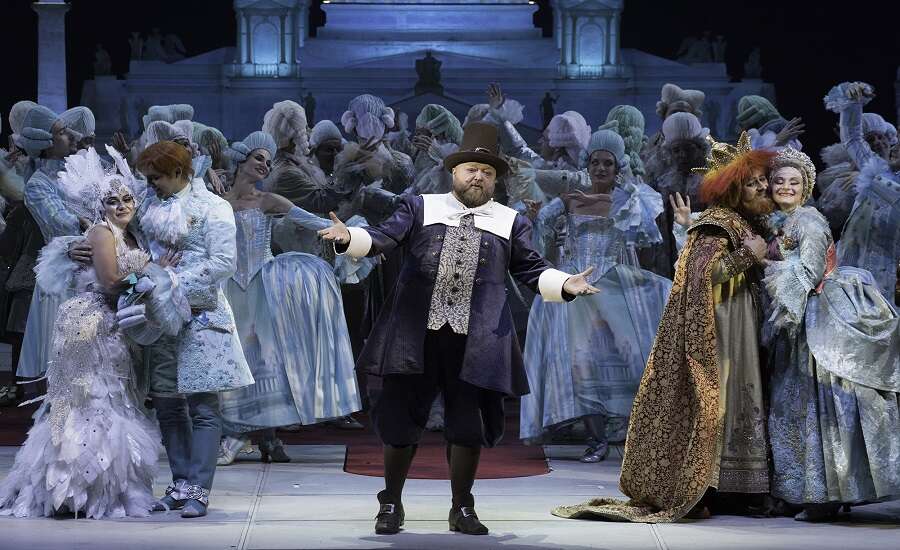
Photo from https://www.bolshoi.ru/
Over the centuries, the Bolshoi Opera company has performed a number of historical premieres. These included Rimsky-Korsakov’s The Maid of Pskov, with Fyodor Shalyapin as Ivan the Terrible, in October 1901, and Shostakovich’s Lady Macbeth of Mtensk in January 1934, which was then censored for nearly 30 years. Interestingly, although the premiere of Mussorgky’s Boris Godunov in December 1888 was badly received, its 1948 revision by Leonid Baratov was so hugely successful, that it has remained in the Bolshoi Opera’s repertoire ever since.
Today, the Bolshoi Opera company specialises in the classics of Russian opera. Staples of the company’s repertoire include the operas of Glinka, Rimsky-Korsakov and Tchaikovsky, and some performances by international composers (predominantly Italian composers such as Verdi and Puccini). Operas at the Bolshoi Theatre are grand spectacles, accompanied with dancers and fantastic stages and costumes.
Realising the artistic and historical importance of the Bolshoi Theatre and its artistic collective, in the mid-1850s the Moscow Office of Imperial Theatres began collecting archival materials. In 1918, a theatre museum was established to house and display these collections and carry out educational work. Today, the museum is home to over 200,000 exhibits, and is a real treasure trove for lovers of theatre. Its collection comprises theatre programmes and posters, sketches of costumes and scenery, props, costumes, photographs and portraits of key artistic figures, architectural drawings of the Bolshoi Theatre, autographs, and personal effects of famous artists.
Tickets for the Bolshoi Theatre can vary hugely in price. In September 2020, tickets for a matinee or evening performance of a famous opera or ballet on the Historical Stage range from 600 to 15,000 roubles, and on the New Stage cost between 200 and 5,000 roubles. Morning performances are cheapest, and evening performances are most expensive.
Bolshoi Theatre tickets are sold in three stages:
For example, for the performances of The Nutcracker on 23rd and 24th September 2020, presale tickets are available from the Bolshoi ticket office on 22nd August at 11:00, tickets are released on the website on 22nd August at 12:00, and the general sale of tickets begins on 28th August at 11:00.
There is no strict dress code for attending the Bolshoi Theatre. An acceptable outfit for a man would be a nice shirt, smart trousers and shoes, and for a woman, smart trousers and top or an elegant dress, with heels or nice boots. If you wish to wear full evening dress, you will certainly not look out of place – attending a performance at the Bolshoi Theatre is a real occasion, and Russians take real pride in their appearance. For more tips on what to pack for a trip to Russia, check out our article.
Essential information for visitors
Address and contact details
Teatralnaya Ploshchad, 1, Moscow, 125009
Nearest metro: Teatralnaya (350m), Okhotny Ryad (400m), Ploshchad Revolutsii (650m)
Website: https://www.bolshoi.ru/en/
Performance schedule and tickets: https://www.bolshoi.ru/en/timetable/
Email: sales@bolshoi.ru
Phone: +7 (495) 455-5555
Join us on Facebook
We invite you to become a fan of our company on Facebook and read Russian news and travel stories. To become a fan, click here.
Join our own Russian Travel, Culture and Literature Club on Facebook. The club was created to be a place for everyone with an interest in Russia to get to know each other and share experiences, stories, pictures and advice. To join our club, please follow this link.